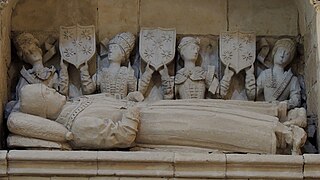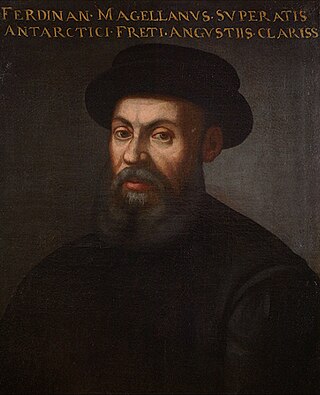
Juan Sebastián Elcano was a Spanish navigator, ship-owner and explorer of Basque origin from Getaria, part of the Crown of Castile when he was born, best known for having completed the first circumnavigation of the Earth in the Spanish ship Victoria on the Magellan expedition to the Spice Islands. He received recognition for his achievement by Charles I of Spain with a coat of arms bearing a globe and the Latin motto Primus circumdedisti me.

Homonhon Island is an island in the province of Eastern Samar, Philippines, on the east side of Leyte Gulf. The 20-kilometre (12 mi) long island is part of the municipality of Guiuan, encompassing eight barangays: Bitaugan, Cagusu-an, Canawayon, Casuguran, Culasi, Habag, Inapulangan, and Pagbabangnan.

Enrique of Malacca, was a Malay member of the Magellan expedition that completed the first circumnavigation of the world in 1519–1522. He was acquired as a slave by the Portuguese explorer Ferdinand Magellan in 1511 at the age of 14 years, probably in the early stages of the capture of Malacca. Magellan's will calls him "a native of Malacca", while Antonio Pigafetta states that he was a native of Sumatra. Magellan took him to Europe, and in 1519 he was brought along on the famous circumnavigation expedition. According to some historians, it is possible that he could be the first person to circumnavigate the globe and return to his starting point, however, there is no record or source that confirms it.

Antonio Pigafetta was a Venetian scholar and explorer. He joined the Spanish expedition to the Spice Islands led by Portuguese explorer Ferdinand Magellan, the world's first circumnavigation, and is best known for being the chronicler of the voyage. During the expedition, he served as Magellan's assistant until Magellan's death in the Philippine Islands, and kept an accurate journal, which later assisted him in translating the Cebuano language. It is the first recorded document concerning the language.

Victoria or Nao Victoria was a carrack famed as the first ship to successfully circumnavigate the world. Victoria was part of the Spanish expedition to the Moluccas commanded by the explorer Ferdinand Magellan.

Juan Rodríguez de Fonseca (1451–1524) was a Spanish archbishop, a courtier and bureaucrat, whose position as royal chaplain to Queen Isabella enabled him to become a powerful counsellor to Ferdinand and Isabella, the Catholic Monarchs. He controlled the Casa de Contratación, an agency which managed expeditions to the New World on behalf of the Spanish crown. He later served as the president of the Council of the Indies, when it was founded in 1521. He managed the administration of a number of significant Spanish expeditions including voyages by Christopher Columbus and Magellan's circumnavigation of the earth.
Cristóbal de Haro was a Castilian financier and merchant from Burgos, famous for having provided funding for the Magellan-Elcano expedition.

João Rodrigues Serrão, also known as Juan Rodríguez Serrano, was a Portuguese and Spanish pilot and explorer. He served in the Portuguese India Armadas that secured control of the Indian Ocean and the Strait of Malacca for the Portuguese but is most well known for his participation in Ferdinand Magellan's 1519–1521 expedition to the Spice Islands for Charles I of Spain, which discovered a path around South America to the Pacific and initiated Spanish involvement in the Philippines. Serrão and Duarte Barbosa became leaders of the expedition after Magellan's death at the Battle of Mactan but did not live to complete the circumnavigation with Elcano. They were both killed shortly thereafter during a massacre of the Spanish by their supposed convert and ally Humabon, raja of Cebu.
Rui (Ruy) Faleiro, also known as Ruy de Faleira, was a Portuguese cosmographer, astrologer, and astronomer who was the principal scientific organizer behind Ferdinand Magellan's circumnavigation of the world.

Estêvão Gomes, also known by the Spanish version of his name Esteban Gómez, was a Portuguese explorer. He sailed in the service of Castile (Spain) in the fleet of Ferdinand Magellan, but deserted the expedition when they had reached the Strait of Magellan and returned to Spain in May 1521. In 1524, he explored the coast of present-day New England and Nova Scotia. As a result of Gomes' expedition, cartographer Diogo Ribeiro was the first to accurately portray North America with a continuous coastline stretching from Florida to Nova Scotia.

The Magellan expedition, sometimes termed the Magellan–Elcano expedition, was a 16th-century Spanish expedition planned and led by Portuguese explorer Ferdinand Magellan. One of the most important voyages in the Age of Discovery—and in the history of exploration—its purpose was to cross the Atlantic and Pacific Oceans to open a trade route with the Moluccas, or Spice Islands, in present-day Indonesia. The expedition departed Spain in 1519 and returned there in 1522 led by Spanish navigator Juan Sebastián Elcano, who crossed the Indian Ocean after Magellan's death in the Philippines. Totaling 60,440 km, or 37,560 mi, the nearly three-year voyage achieved the first circumnavigation of Earth in history. It also revealed the vast scale of the Pacific Ocean and proved that ships could sail around the world on a western sea route.
Andrés de San Martín was the chief pilot-cosmographer (astrologer) of the Armada del Maluco, the fleet commanded by Ferdinand Magellan in 1519. He is presumed to have died during that expedition in Cebu.

Ferdinand Magellan was a Portuguese explorer best known for having planned and led the 1519–22 Spanish expedition to the East Indies, which achieved the first circumnavigation of Earth in history. During the expedition, he also discovered the Strait of Magellan, allowing his fleet to pass from the Atlantic into the Pacific Ocean and perform the first European navigation to Asia via the Pacific. Magellan died in the Philippines during his voyage, and his crew completed the return trip to Spain in 1522.
Francisco Combés, SJ was a Spanish Jesuit priest who established Christian monasteries in the Philippines in the 17th century.

Laurence Bergreen is an American historian and author.

Trinidad was the flagship of Ferdinand Magellan's 1519–22 voyage of circumnavigation. Unlike the Victoria, which successfully returned to Spain after sailing across the Indian Ocean under the command of Juan Sebastián Elcano, Trinidad attempted yet failed to sail east across the Pacific to New Spain.

The Treaty of Zaragoza or Saragossa, also called the Capitulation of Zaragoza or Saragossa, was a peace treaty between Castile and Portugal, signed on 22 April 1529 by King John III of Portugal and the Habsburg emperor Charles V in the Aragonese city of Zaragoza. The treaty defined the areas of Castilian and Portuguese influence in Asia in order to resolve the "Moluccas issue", which had arisen because both kingdoms claimed the lucrative Spice Islands for themselves, asserting that they were within their area of influence as specified in 1494 by the Treaty of Tordesillas. The conflict began in 1520, when expeditions from both kingdoms reached the Pacific Ocean, because no agreed meridian of longitude had been established in the far east.

The Magellan expedition was the first voyage around the world in human history. It was a Spanish expedition that sailed from Seville in 1519 under the initial command of Ferdinand Magellan, a Portuguese sailor, and completed in 1522 by Spanish Basque navigator Juan Sebastián Elcano.
Gaspar de Quesada was a Spanish explorer who participated in Magellan's circumnavigation as captain of the Concepción, one of the expedition's five ships. Approximately six months in to the expedition, Quesada, with two other Spanish captains, attempted to overthrow Magellan in the Easter mutiny at the South American port of St. Julian. The mutiny failed and Magellan had Quesada executed.

Luis de Mendoza was a Spanish mariner and explorer.















